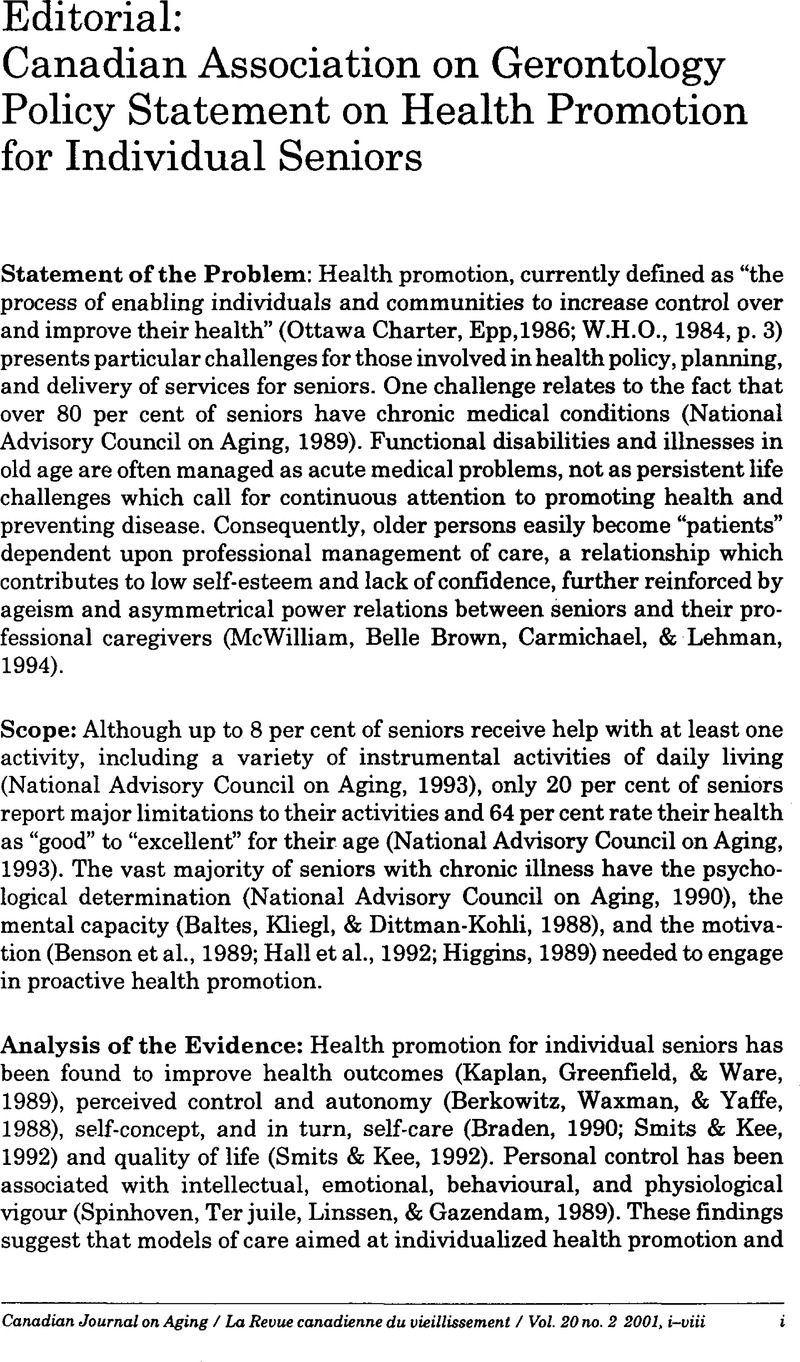No CrossRef data available.
Article contents
Editorial: Canadian Association on Gerontology Policy Statement on Health Promotion for Individual Seniors
Published online by Cambridge University Press: 29 November 2010
Abstract
An abstract is not available for this content so a preview has been provided. As you have access to this content, a full PDF is available via the ‘Save PDF’ action button.

- Type
- Editorial/Éditorial
- Information
- Canadian Journal on Aging / La Revue canadienne du vieillissement , Volume 20 , Issue 2 , Été/Summer 2001 , pp. i - iv
- Copyright
- Copyright © Canadian Association on Gerontology 2001
References
Baltes, P.B., Kliegl, R., & Dittman-Kohli, F. (1988). On the locus of training gains in research on the plasticity of fluid intelligence in old age. Journal of Educational Psychology, 880, 392–400.CrossRefGoogle Scholar
Benson, L., Nelson, E., Napps, S., Roberts, E., Kane-Williams, E., & Salisbury, R. (1989). Evaluation of staying healthy after fifty educational program: Impact on course participants. Health Education Quarterly, 16(4), 485–508.CrossRefGoogle ScholarPubMed
Berkowitz, M.W., Waxman, R., & Yaffe, L. (1988). The effects of a resident self-help model on control, social involvement and self-esteem among the elderly. The Gerontologist, 28(5), 620–624.CrossRefGoogle ScholarPubMed
Braden, C.J. (1990). A test of the self-help model: Learned response to chronic illness experience. Nursing Research, 39(1), 42–47.CrossRefGoogle ScholarPubMed
Cox, E.O., & Parsons, R.R. (1996). Empowerment-oriented social work practice: Impact of late life relationships of women. Journal of Women and Aging, 8, 129–143.CrossRefGoogle Scholar
Elder, J.P., Williams, S.J., & Drew, J.A. (1995). Longitudinal effects of preventive services on health behaviors among an elderly cohort. American Journal of Preventive Medicine, 11, 354.CrossRefGoogle ScholarPubMed
Epp, J. (1986). Achieving health for all: A framework for health promotion. Ottawa: Minister of Supply & Services.Google ScholarPubMed
Fries, J.F., Bloch, D.A., Harrington, H., Richardson, N., & Beck, R. (1993). Two-year results of a randomized controlled trial of a health promotion program in a retiree population: The bank of America study. The American Journal of Medicine, 94, 455–462.CrossRefGoogle Scholar
Hall, N., De Beck, P., Johnson, D., Mackinnon, K, Gutman, G., & Glick, N. (1992). Randomized trial of a health promotion program for frail elders. Canadian Journal on Aging, 11, 72–100.CrossRefGoogle Scholar
Hamdorf, P.A., Withers, R.T., Penhall, R.K., & Haslam, M.V. (1992). Physical training effects on the fitness and habitual activity patterns of elderly women. Archives of Physical Medicine and Rehabilitation, 73, 603–608.Google ScholarPubMed
Higgins, P. (1989). Short term changes in health behaviours of older adults. The Canadian Journal of Nursing Research, 21(1), 19–32.Google Scholar
Kaplan, G.A., Greenfield, S., & Ware, J.E. Jr (1989). Assessing the effects of physician-patient interactions on the outcomes of chronic disease. In K.N. Lohr (Ed.), Advances in health status assessment. Medical Care, 27(suppl. 1), 110–127.CrossRefGoogle ScholarPubMed
Leigh, J.P., Richardson, N., Beck, R., Kerr, C, Harrington, H., Parcell, C.L., & Fries, J.F. (1992). Randomized controlled study of a retiree health promotion program: The Bank of America study. Archives of Internal Medicine, 152, 1201–1206.CrossRefGoogle Scholar
McWilliam, C.L., Belle, Brown J., Carmichael, J.L., & Lehman, J.M. (1994). A new perspective on threatened autonomy in elderly persons: The disempowering process. Social Science and Medicine, 38, 327–338.CrossRefGoogle ScholarPubMed
McWilliam, C.L., Stewart, M., Brown, J.B., McNair, S., Donner, A., Desai, K., Coderre, P., & Galajda, J. (1999). A randomized control trial of a critical reflection approach to home-based health promotion for chronically ill older persons. Health Promotion International, 14(1), 27–41.CrossRefGoogle Scholar
National Advisory Council on Aging. (1989). Understanding seniors' independence report #1: The barriers and suggestions for action. Ottawa: Ministry of Supply and Services Canada.Google Scholar
National Advisory Council on Aging. (1990). A Portrait of seniors in Canada. Ottawa: Statistics Canada, cat. No. 89–159.Google Scholar
National Advisory Council on Aging. (1993). Aging vignettes. Ottawa: Government of Canada.Google Scholar
Ruffing-Rahal, M.A. (1994). Evaluation of group health promotion with community- dwelling older women. Public Health Nursing, 11, 38–48.CrossRefGoogle ScholarPubMed
Smits, M., & Kee, C. (1992). Correlates of self-care among the independent elderly: Self-concept affects well-being. Journal of Gerontological Nursing, 18(9), 13–18.CrossRefGoogle ScholarPubMed
Spinhoven, P., Ter, Juile M., Linssen, A., & Gazendam, B. (1989). Pain coping strategies in a Dutch population of chronic low back pain patients. Pain, 37(1), 77–83.CrossRefGoogle Scholar
Schweitzer, S.O., Atchison, K.A., Lubben, J.E., Mayer-Oakes, S.A., De Jong, F.J., & Matthias, R.E. (1994). Health promotion and disease prevention for older adults: Opportunity for change of preaching to the converted? American Journal of Preventive Medicine, 10, 223–229.CrossRefGoogle Scholar
World Health Organization. (1984). Health promotion, a discussion document on the concept and principles. Copenhagen; W.H.O., Regional Office for Europe.Google Scholar




